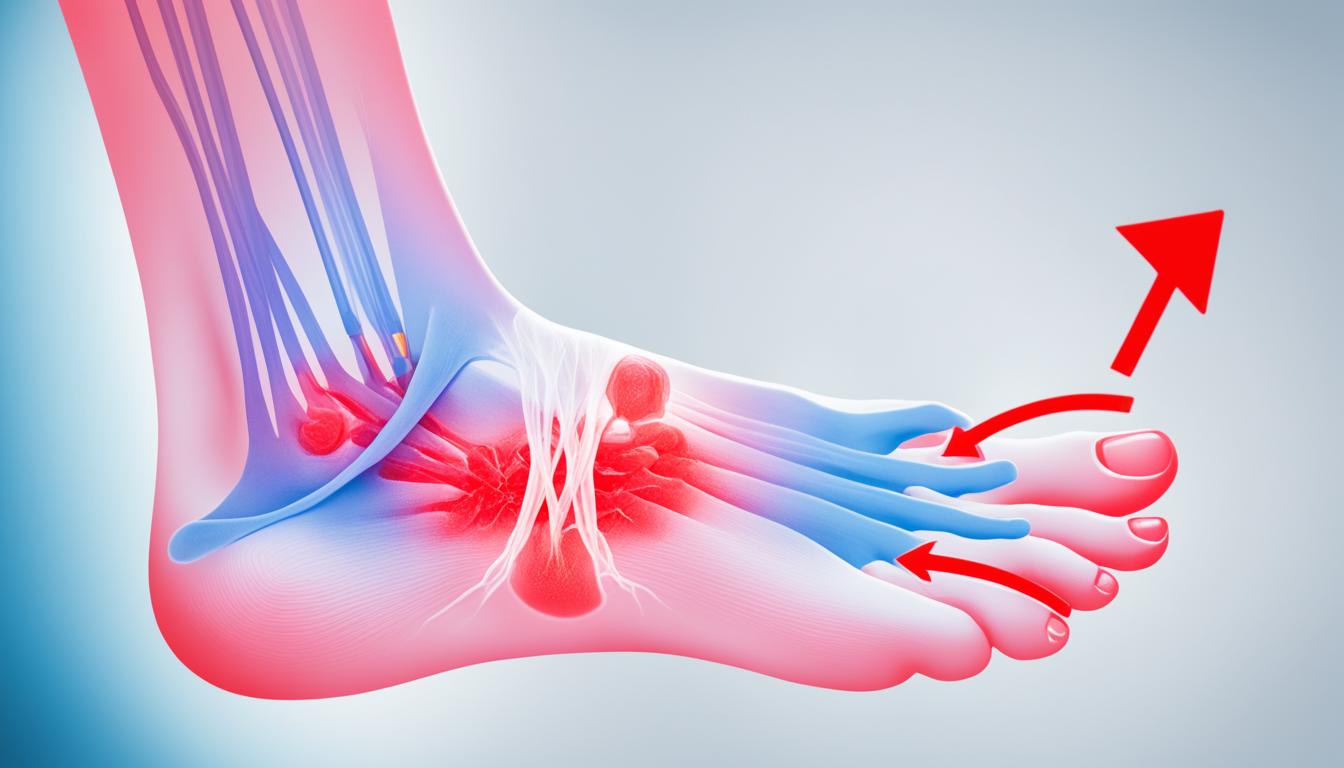Neuroma Morton’s, also known as Morton’s neuroma, causes persistent foot pain. People often say it feels like they are stepping on a marble. The issue is not a cancer tumor but a swelling around a nerve in the foot. It happens when nerves get twisted at the foot’s base or between toes. Doctors sometimes mix it up with metatarsalgia because the pain and signs can be alike.
To diagnose Neuroma Morton’s, doctors listen to your symptoms and do tests. Ultrasound or MRI can confirm if you have it. At first, you might try easy solutions like better shoes, foot supports, and pills to fight swelling. But if these don’t help, your doctor may suggest other options. This can include shots or treatments to freeze or burn the nerve. In severe cases, they might have to remove the swollen nerve. There’s also a new hope in using stem cells to treat this problem. This approach seems to help with pain and heal damaged tissue.
Key Takeaways:
- Neuroma Morton’s leads to pain at the foot’s base.
- Nerves get tangled at the foot’s base or between toes, causing this problem.
- It can be hard to tell Neuroma Morton’s apart from metatarsalgia at first.
- Doctors check symptoms and use tests like ultrasound to confirm the issue.
- Starting with easy fixes like good shoes and supports is often the first step.
- But if needed, more serious treatments or even surgery might be considered.
Causes and Diagnosis of Neuroma Morton’s
What exactly causes Neuroma Morton’s isn’t fully clear, but we have some ideas. Wearing tight, high-heeled shoes for long can make it more likely to happen. This is because those shoes push on the foot bones and squeeze the nerves. If you have foot issues like bunions or flat feet, your risk goes up. Doing sports that hit your feet over and over, or being too heavy, can also be factors.
Choosing the right shoes is key to avoiding Neuroma Morton’s. Make sure your shoes don’t squish your toes and have low heels. This helps lower the pressure on your feet. It’s also important to stay a healthy weight and not do activities that hurt your feet too much for prevention.
Diagnosis of Neuroma Morton’s
Finding out you have Neuroma Morton’s is a mix of looking at symptoms and doing tests. Doctors look at what you’re feeling like pain or tingling in your foot. They also check by pressing on your foot to see if it hurts or if there’s a bump.
If it’s still not clear, they might use ultrasound or MRI scans. Ultrasound shows the neuroma, while MRI looks for other foot problems. These tests can clear up any doubts about the diagnosis.
Early diagnosis is really important for treating Neuroma Morton’s well. So, if your foot hurts a lot or you think you might have this, see a doctor as soon as you can. This way, you can get the right care and avoid more problems.
Treatment Options for Neuroma Morton’s
Dealing with Neuroma Morton’s focuses mainly on easing pain and aiding in healing. Key first steps include wearing shoes that are spacious and comfy. These shoes have a wide front that eases pressure and gives the toes room to move.
Inserting orthotic devices into the shoes is another helpful step. By customizing these inserts to fit the foot, they reduce pressure. This kind of support also keeps the foot properly aligned, thanks to targeted cushioning and arch support.
Avoiding activities that stress the foot is very important. Stay away from sports or activities that hit the foot repeatedly. Doing so worsens the condition and slows down recovery.
If simple treatments don’t work, there are other options. For some, local anesthetic or steroid shots might be effective. These shots reduce pain and swelling, making daily life more bearable. However, remember that their relief may not last forever.

